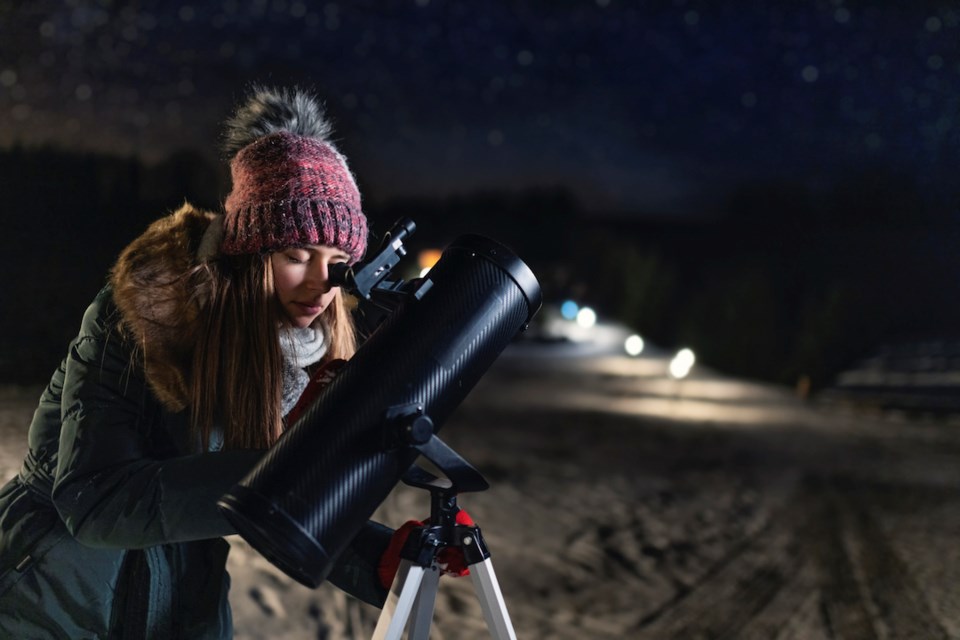March begins with a pretty and spectacular conjunction of Venus and Jupiter after sunset on March 1. We began to actually have some clear skies in late February and we could look to the west after sunset to see Venus moving east and up as it swung around from behind the sun to catch up to Earth. As I mentioned last month, Venus will have moved alongside Jupiter and the two will be about half a degree apart – the width of the moon. With a steady pair of binoculars, you’ll be able to see the two planets and Jupiter’s four moons, all of them strung out to its upper left and everything in the same field of view.
Why this conjunction? Jupiter moves more slowly than both Venus and Earth so our own motion around the sun makes it appear that Jupiter is headed west and into the sun. To visualize these motions, imagine that our solar system is a very large, very slow carousel where the horses (planets) aren’t fixed to the floor but rotate around the centre at different speeds, close ones fastest and farthest out the slowest. Occasionally, like on March 1, the horses appear to be lined up along the same line of sight. And, if you find that easy, imagine the floor isn’t flat – depressed in the centre and higher the farther out you go, with everything behaving like a vortex around your bathtub drain. It’s low, steep and fast close in and higher, flatter and slower farther out. Then try to figure out how to roll a tennis ball from one horse to another while the whole shebang is rotating. If you find that easy, NASA may be interested in your resume.
There is a full moon on March 7 so for the next two weeks or so, with the moon rising later after sunset each night, we may get a chance to see the zodiacal light. This phenomenon is just the faint reflection of sunlight off the tiny bits of dust orbiting around the sun in the same plane as the planets – the ecliptic. Venus and Jupiter will show the ecliptic location very clearly, so look for a very faint diffuse triangle lined up with the ecliptic, broader at the horizon and narrowing farther up and left. A dark sky is mandatory so stay away from light sources and let your eyes fully adapt to the dark. I’ve seen this a number of times from Hawaii but never from Sechelt; maybe this time I’ll manage it.
A difficult conjunction occurs in the afternoon of March 22, one day after the new moon. It may be possible to see a very thin crescent moon about twelve degrees above and left of the sun; it’s easier if you can get behind something to just block the sun. Remember the location and wait until about 18:30 – just after sunset – and, if you can find the crescent moon, look about the width of your thumb below and towards the sun and you should see Jupiter. It’s easier to see with binoculars but ONLY after the sun is below the horizon.
In fact, March 22 marks the start of four planets in the west after sunset: at about 19:00, Mars is about 60 degrees up in the southwest, Venus is 25 degrees above the western horizon and moving east, Jupiter is about 5 degrees above the horizon and moving west. For the rest of the month, they will be joined by Mercury, very low but starting to move east, coming out from behind the sun. On March 27 it will pass about a thumb width to the right of Jupiter, when they’ll both be about three degrees above the horizon. By month-end, Jupiter will be sinking into the horizon and Mercury will have moved about a quarter of the way up to Venus. The moon will pass Jupiter, Venus and Mars from March 22 through March 28. Another possible cool sight on March 22 will be when the ISS should rise in the WNW at about 21:00, just left of the moon and Venus. (Yes, the ISS does rise in the west. Everything else rises in the east because Earth rotates that way faster than they rotate around us. They just look like they’re moving east to west.) The ISS timings are a bit iffy since NASA adjusts the orbit periodically to account for the very slight drag of Earth’s upper atmosphere that causes a slow drop in the station’s altitude. Check Heavens Above for ISS passes nearer the date to get better timings.
The March club meeting, open to the public, will be at the Sechelt Library at 7 p.m. March 10. Although the presentation is as yet to be determined; updates will be posted at the Sunshine Coast Club website at: https://sunshinecoastastronomy.wordpress.com. We hope to see you there.



